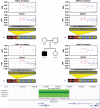Modeling genetic inheritance of copy number variations
- PMID: 18832372
- PMCID: PMC2588508
- DOI: 10.1093/nar/gkn641
Modeling genetic inheritance of copy number variations
Abstract
Copy number variations (CNVs) are being used as genetic markers or functional candidates in gene-mapping studies. However, unlike single nucleotide polymorphism or microsatellite genotyping techniques, most CNV detection methods are limited to detecting total copy numbers, rather than copy number in each of the two homologous chromosomes. To address this issue, we developed a statistical framework for intensity-based CNV detection platforms using family data. Our algorithm identifies CNVs for a family simultaneously, thus avoiding the generation of calls with Mendelian inconsistency while maintaining the ability to detect de novo CNVs. Applications to simulated data and real data indicate that our method significantly improves both call rates and accuracy of boundary inference, compared to existing approaches. We further illustrate the use of Mendelian inheritance to infer SNP allele compositions in each of the two homologous chromosomes in CNV regions using real data. Finally, we applied our method to a set of families genotyped using both the Illumina HumanHap550 and Affymetrix genome-wide 5.0 arrays to demonstrate its performance on both inherited and de novo CNVs. In conclusion, our method produces accurate CNV calls, gives probabilistic estimates of CNV transmission and builds a solid foundation for the development of linkage and association tests utilizing CNVs.
Figures





Similar articles
-
Genome-wide detection of human copy number variations using high-density DNA oligonucleotide arrays.Genome Res. 2006 Dec;16(12):1575-84. doi: 10.1101/gr.5629106. Epub 2006 Nov 22. Genome Res. 2006. PMID: 17122084 Free PMC article.
-
Comprehensive performance comparison of high-resolution array platforms for genome-wide Copy Number Variation (CNV) analysis in humans.BMC Genomics. 2017 Apr 24;18(1):321. doi: 10.1186/s12864-017-3658-x. BMC Genomics. 2017. PMID: 28438122 Free PMC article.
-
Copy number variations in the genome of the Qatari population.BMC Genomics. 2015 Oct 22;16:834. doi: 10.1186/s12864-015-1991-5. BMC Genomics. 2015. PMID: 26490036 Free PMC article.
-
Deciphering new insights into copy number variations as drivers of genomic diversity and adaptation in farm animal species.Gene. 2025 Mar 5;939:149159. doi: 10.1016/j.gene.2024.149159. Epub 2024 Dec 11. Gene. 2025. PMID: 39672215 Review.
-
CNV discovery using SNP genotyping arrays.Cytogenet Genome Res. 2008;123(1-4):307-12. doi: 10.1159/000184722. Epub 2009 Mar 11. Cytogenet Genome Res. 2008. PMID: 19287169 Review.
Cited by
-
Sensitive and specific detection of mosaic chromosomal abnormalities using the Parent-of-Origin-based Detection (POD) method.BMC Genomics. 2013 May 31;14:367. doi: 10.1186/1471-2164-14-367. BMC Genomics. 2013. PMID: 23724825 Free PMC article.
-
Recurrent Rare Copy Number Variants Increase Risk for Esotropia.Invest Ophthalmol Vis Sci. 2020 Aug 3;61(10):22. doi: 10.1167/iovs.61.10.22. Invest Ophthalmol Vis Sci. 2020. PMID: 32780866 Free PMC article.
-
Inheritance model introduces differential bias in CNV calls between parents and offspring.Genet Epidemiol. 2012 Jul;36(5):488-98. doi: 10.1002/gepi.21643. Epub 2012 May 24. Genet Epidemiol. 2012. PMID: 22628073 Free PMC article.
-
A genome-wide study of inherited deletions identified two regions associated with nonsyndromic isolated oral clefts.Birth Defects Res A Clin Mol Teratol. 2015 Apr;103(4):276-83. doi: 10.1002/bdra.23362. Epub 2015 Mar 16. Birth Defects Res A Clin Mol Teratol. 2015. PMID: 25776870 Free PMC article.
-
Exome sequencing of 457 autism families recruited online provides evidence for autism risk genes.NPJ Genom Med. 2019 Aug 23;4:19. doi: 10.1038/s41525-019-0093-8. eCollection 2019. NPJ Genom Med. 2019. PMID: 31452935 Free PMC article.
References
-
- Feuk L, Carson AR, Scherer SW. Structural variation in the human genome. Nat. Rev. Genet. 2006;7:85–97. - PubMed
-
- Beckmann JS, Estivill X, Antonarakis SE. Copy number variants and genetic traits: closer to the resolution of phenotypic to genotypic variability. Nat. Rev. Genet. 2007;8:639–646. - PubMed
Publication types
MeSH terms
Grants and funding
LinkOut - more resources
Full Text Sources
Molecular Biology Databases
Miscellaneous

